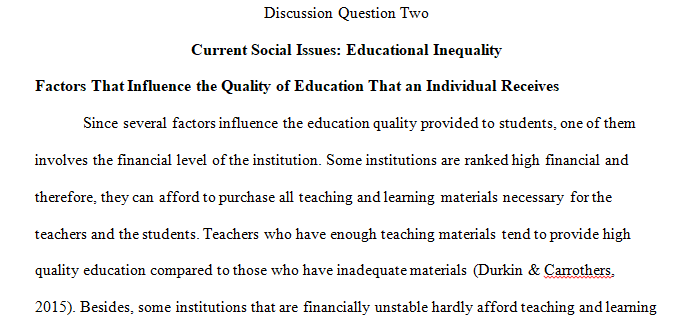
What factors influence the quality of education that an individual receives?
Current Social Issues: Educational Inequality
WK 4 Discussion Question 1
| Social Institutions |
Vessing (2011) states, “a society needs a variety of social institutions in order to function adequately. However, it does appear that not all citizens have equal access to participation in them, and that one’s social class and ascribed characteristics may limit one’s ability to benefit from them. This disparity results in unequal access to all that the institutions have to offer” (p. 197). Review the various social institutions discussed in Chapters 10 and 11 of the text, Sociology: Beyond Common Sense.
Based on what you have read in the text, describe at least two institutions that do not provide equal access? If you were asked to implement changes from a sociological perspective, what changes would you suggest? Support your answer with detailed examples.
Your initial post should be at least 250 words in length. Support your claims with examples from required material(s) and/or other scholarly resources, and properly cite any references. Respond to at least two of your classmates’ posts by Day 7.
Reference:
Vissing, Y. (2011). Introduction to sociology. San Diego, CA: Bridgepoint Education
Discussion Question 2
| Current Social Issues: Educational Inequality |
According to conflict theorists, the persistence of social class inequality can be linked to the educational institutions in the United States. Although education is asserted to be a social equalizer, many argue that the educational system is a mechanism of social reproduction that maintains social inequality rather than ensuring equality of opportunity. For this discussion, you will read Chapters 10 and 11 of the text, Sociology: Beyond Common Sense, and review the article, Foundations of Educational Inequality.
Answer the following questions:
- What factors influence the quality of education that an individual receives?
- How is social class reproduced through the educational system?
- How is this continuing educational inequality impacting other social institutions?
Your initial post should be at least 250 words in length. Support your claims with examples from required material(s) and/or other scholarly resources, and properly cite any references.
Required Resources
TEXT
Durkin, K. F., & Carrothers, R. M. (2015). Sociology: Beyond common sense [Electronic version]. Retrieved from https://content.ashford.edu/
- Chapter 10: Institutions I: The Family, Economy and Education
- Chapter 11: Institutions II: Politics and Government, Religion and Health
ARTICLE
Winkle-Wagner, R. (2010). Foundations of educational inequality: Cultural capital and social reproduction. ASHE Higher Education Report, 36(1), 1-21. doi: 10.1002/aehe.3601
- The full-text version of this article can be accessed through the EBSCOhost database in the Ashford University Library. This resource is provided as an alternative and supplemental viewpoint to the text and provides greater detail in relation to the topic of Educational Inequality.
REQUIREMENTS
Social Science
Answer preview………………….

apa 356 words